SEO for Startups: How Startups Can Unlock Growth With SEO

SEO for startups can be overwhelming — but don’t let it keep you from getting started.

Contrary to what you might think, startups have many SEO advantages. Thanks to lean processes, startups can be reactive and publish faster.
I’m an SEO consultant, and one of my clients (a startup) began working with me when they had five clicks per month; they’re now getting 15,300 clicks.
In this comprehensive blog, I walk you through everything you need for an effective SEO strategy for your startup.
I’ll cover why startups need SEO, a detailed step-by-step guide on how to do SEO for startups, and tips from entrepreneurs and SEO professionals who have had great success.
Table of Contents
Why Startups Need SEO in 2024
There are many reasons startups need SEO in 2024, but I’ll share my top four.
SEO drives business growth.
If marketing and SEO aren’t making money for your business, then there’s no point in doing it.
The primary purpose of marketing is sales. SEO should get you to the top of Google for your most desired keywords, including money-generating keywords.
I don’t want to make it sound easy because it will be a lot of work, especially if your website is new, but once you’ve earned those top spots, you can expect sales to come to you.
Here’s an example: the keyword “printed song lyrics” (and its variations) has a monthly search volume of 4,600 searches.
As pictured below, you can see Google’s search engine results pages (SERPs) list Chatterbox Walls, Song Lyric Prints, Thoughtful Keepsake, Moonshine Prints, and The Bespoke Foil Company.
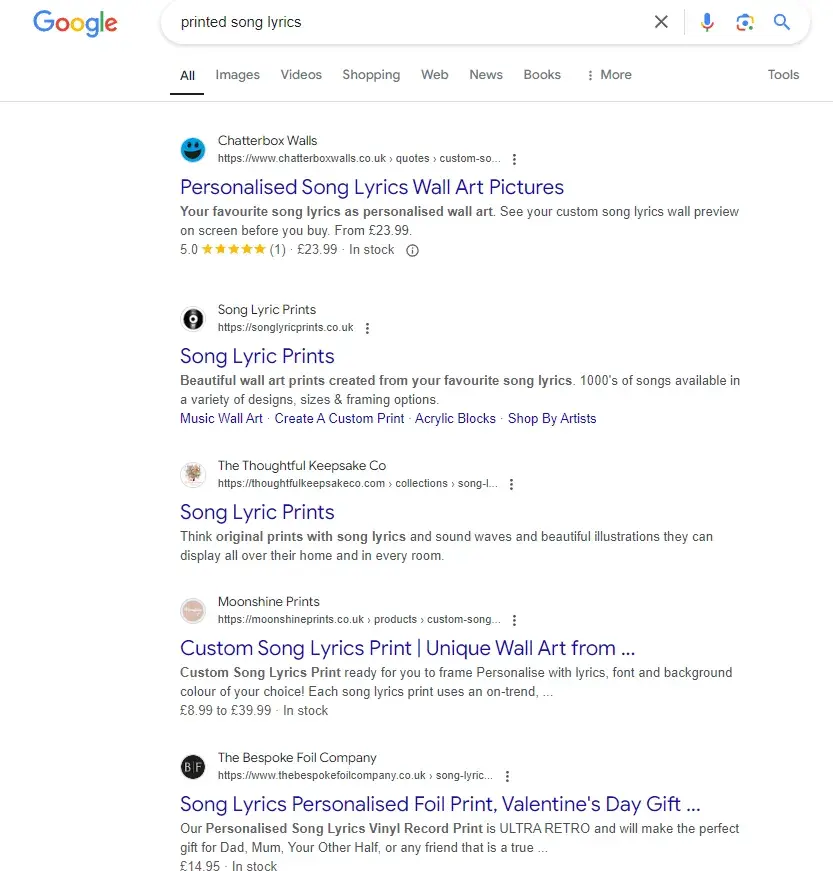
All of these businesses sell custom song lyrics prints. According to keyword research tools, a top spot for this keyword (printed song lyrics) could result in up to 4,600 clicks.
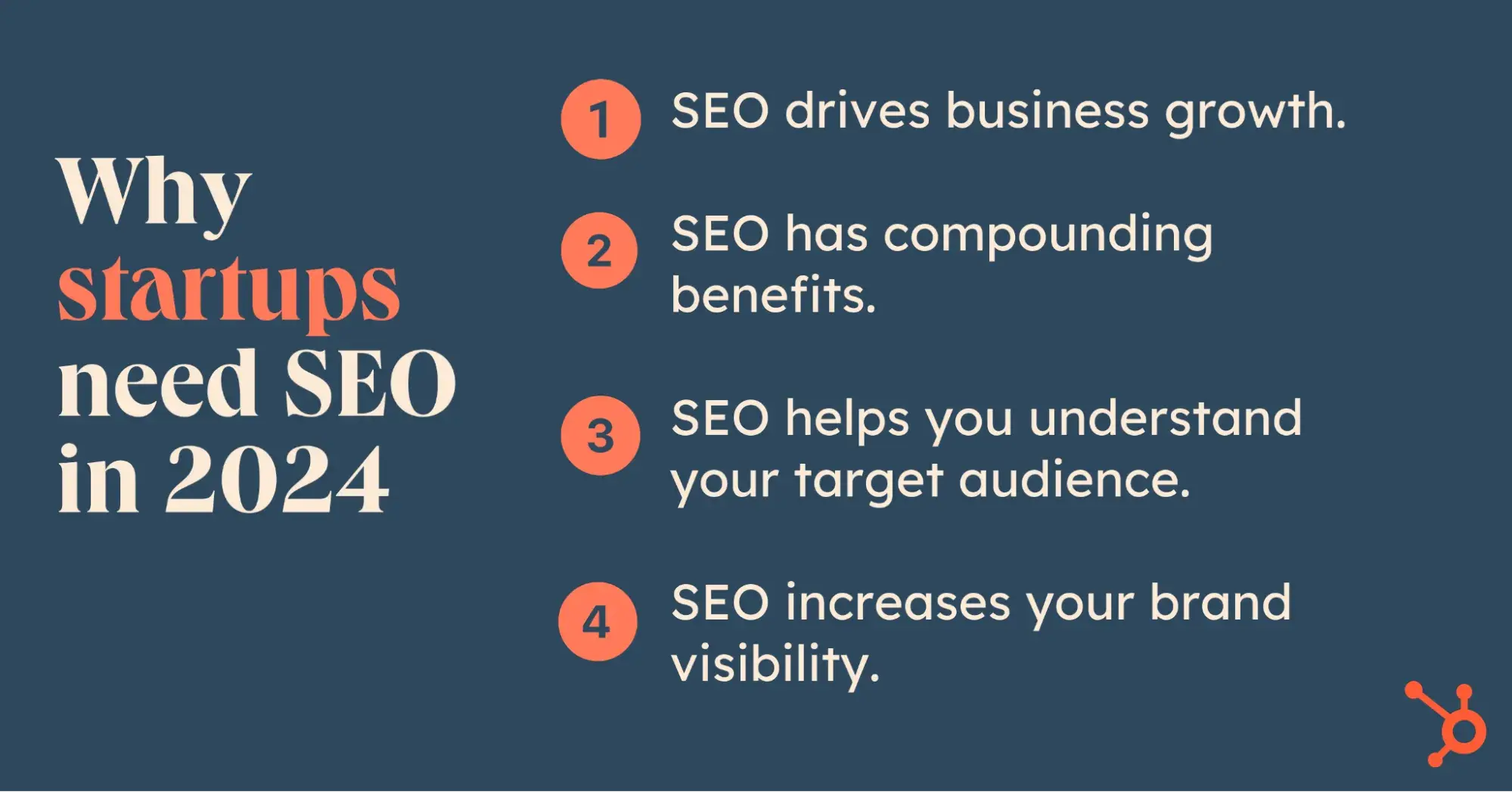
SEO has compounding benefits.
Once you’ve earned a rank, it’s (generally) manageable to keep it there, making SEO cost-effective or sometimes free to continue ranking.
This is the compounding benefit of SEO: your hard work pays off for months, maybe even years, after you’ve done it.
I advocate using SEO and PPC together, but I’m using a PPC example to demonstrate my point.
For the keyword above (printed song lyrics), the keyword research tool Semrush estimates ad clicks at $0.65/click (see CPC on the right of the screenshot below).
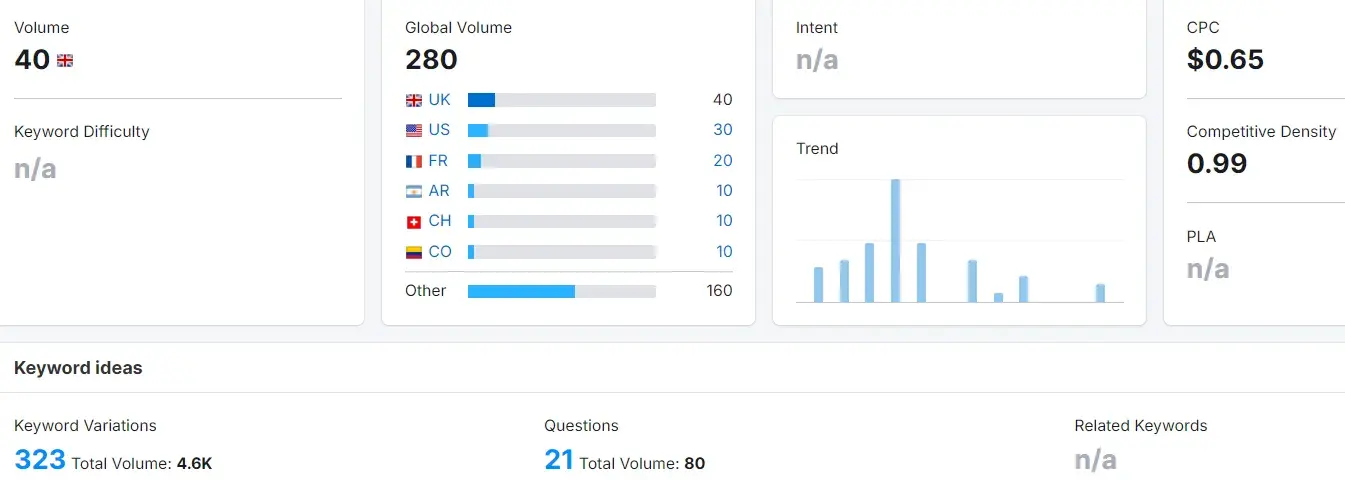
If you were using PPC only, you’d pay $0.65 per click to your website for the keyword “printed song lyrics.”
Semrush says there are 4,600 monthly searches, so $0.65 x 4600 = $2,990/month or $35,880/year to get the same click opportunity using paid ads.
Of course, SEO isn’t free because it takes time for you or your team to implement it, but with its compounding benefits, you may find SEO profitable in the long run.
SEO helps you understand your target audience.
When you undertake keyword research, which we’ll discuss later, you start to understand what your target audience is searching for and how you can best serve them.
In the screenshot below, I’ve used AlsoAsked to find questions related to the keyword “paper anniversary gifts.”
Sticking with the printed song lyrics keyword: businesses selling printed lyrics might promote the product as a gift for the paper anniversary.
AlsoAsked gives you the questions (think of these as keywords) people are typing into Google.
If you answer these questions on your website, you might be able to rank, but there’s more. You know what people are searching for, and you can use this data to serve them before they come to Google.
What I mean is that you can repurpose content onto other platforms; perhaps you’ve got a mailing list or a social media following to take answers to your target audience in other formats.
Startups don’t do enough repurposing content.
According to HubSpot’s web strategy survey of 300+ US web strategists and SEOs, smaller websites (assuming smaller businesses) repurpose content onto social media only 24% to 51% of the time.
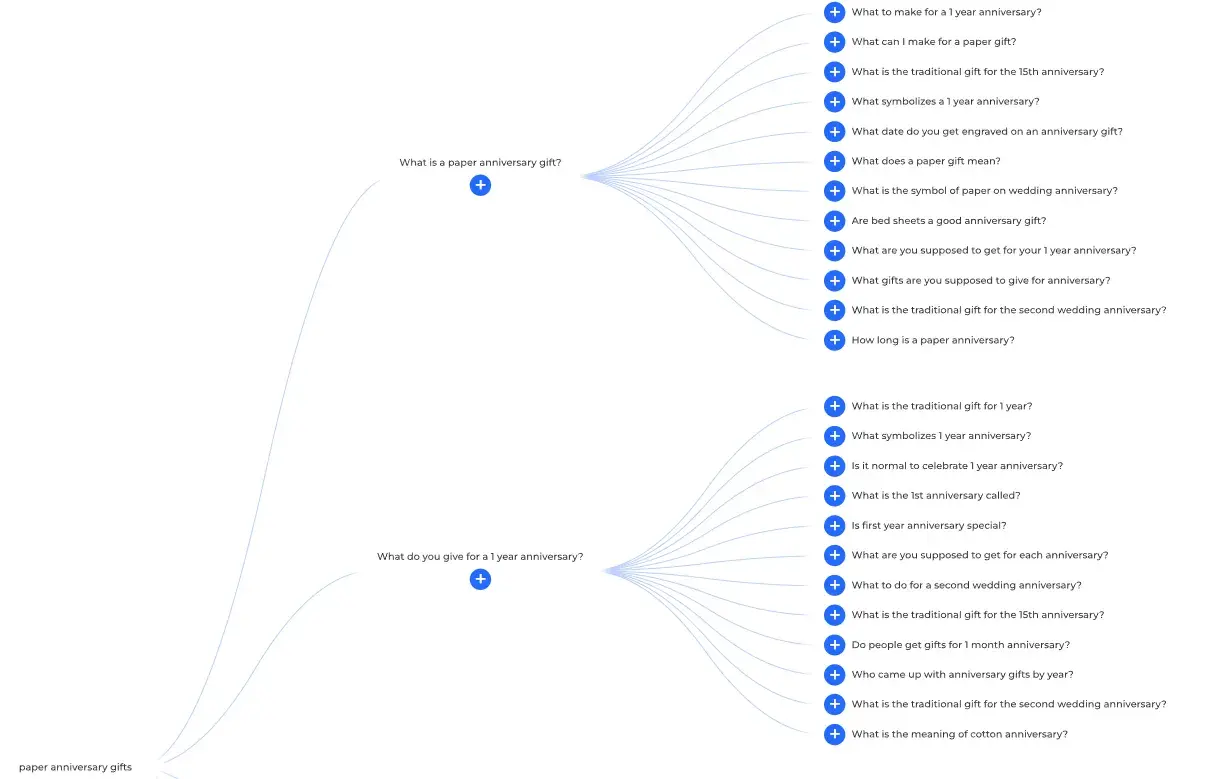
SEO increases your brand visibility.
If you do your research and strategically create content for SEO, you will undoubtedly increase brand visibility. Your website will start appearing for your audience when they need you the most.
I helped one startup increase the number of clicks on its website from five per month to 9,574. We earn a lot of traffic through their blog, products, and pages designed to educate or convert.
The screenshots below show the difference.
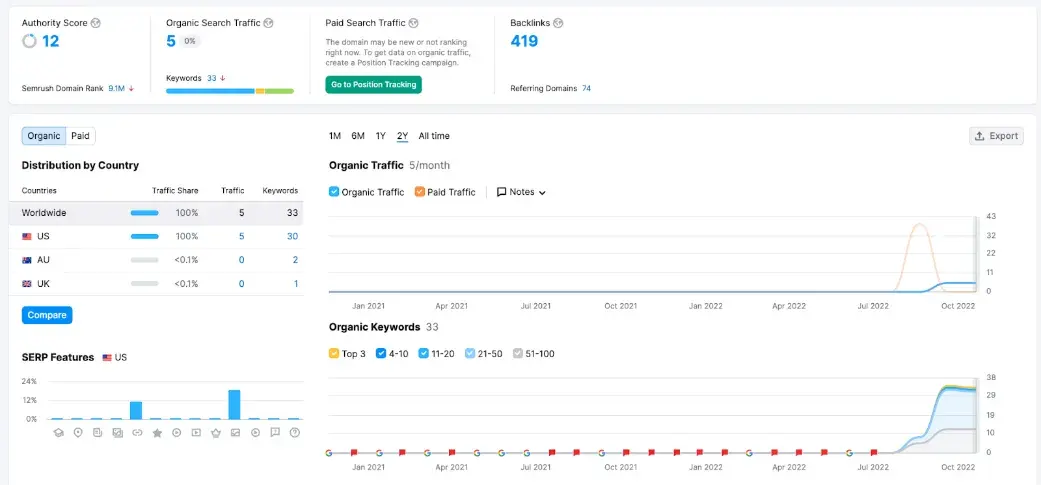

It’s fair to say that SEO has helped this brand reach qualified traffic.
In HubSpot’s web strategy survey, when asked about the most important metrics to assess a website’s performance, the winning results were “Sales, leads, and conversion rates” (33%) and “Total monthly visitors” (32%).
To some degree, sales depend on monthly visitors as long as you get clicks from the right audiences.
Why AI Overviews and AI-Powered Search Engines Matter for SEO
As an SEO, I hear a lot about how SEO is over and that AI is where you need to focus. However, mentions in AI are part of SEO, and I can show you how this works.
The screenshot below shows my client, Gaia Learning, a startup ranking number one organically and within AI overviews. The great content, steered by SEO, means they’re featured in four places right at the top of Google.
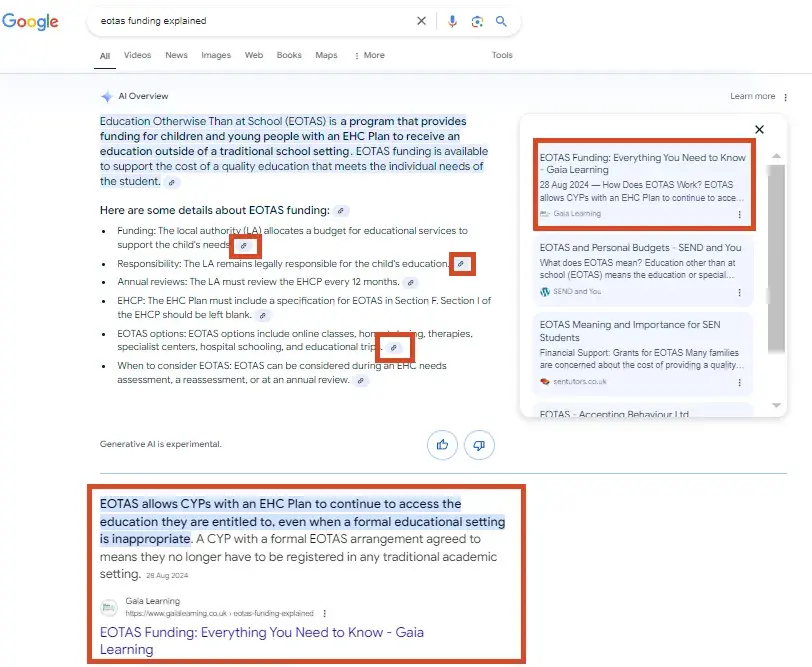
The same content helps Gaia Learning earn mentions from AI tools like ChatGPT, see below.
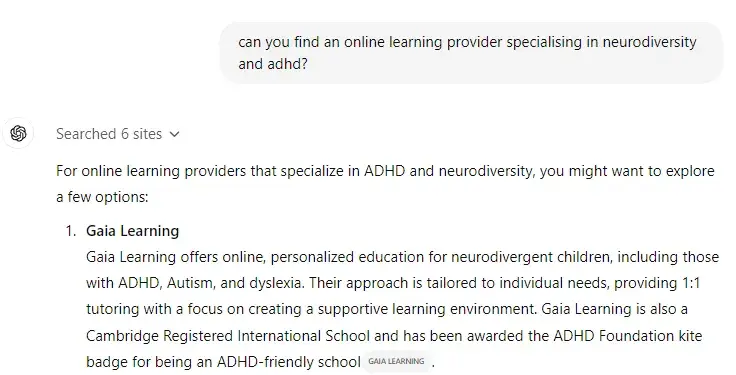
Although exposure through AI tools and overviews is cool and something to aim for (I don’t think AI is going anywhere), it’s probably best not to fixate on it too much.
HubSpot asked 300+ US-based web strategists and SEOs if AI overviews impacted site traffic. Respondents reported that since AI overviews came in, their sites got more traffic (41%) or the same amount of traffic (42%).
AI overviews are not that significant yet; users are scrolling to the organic listing.
You can use Hubspot’s AI Search Grader if you’re curious about your brand’s prominence in AI-powered search engines.
Fill out four fields: company name, location, product or service, and company type, and you’ll get an overview like the one below.
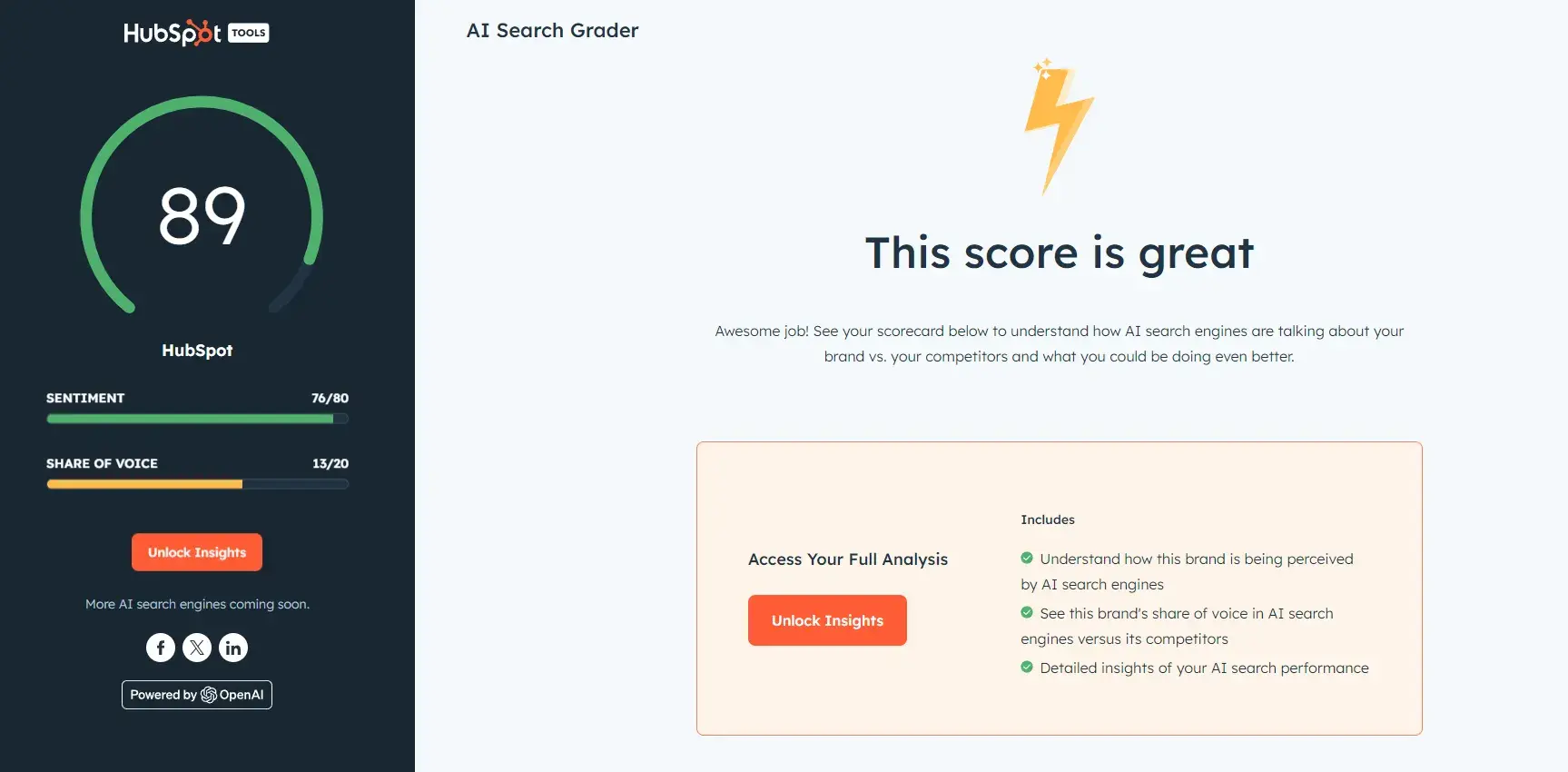
If you want to unlock more insights, click that orange button, provide an email address, and you’ll receive in-depth insights into your brand’s prominence.
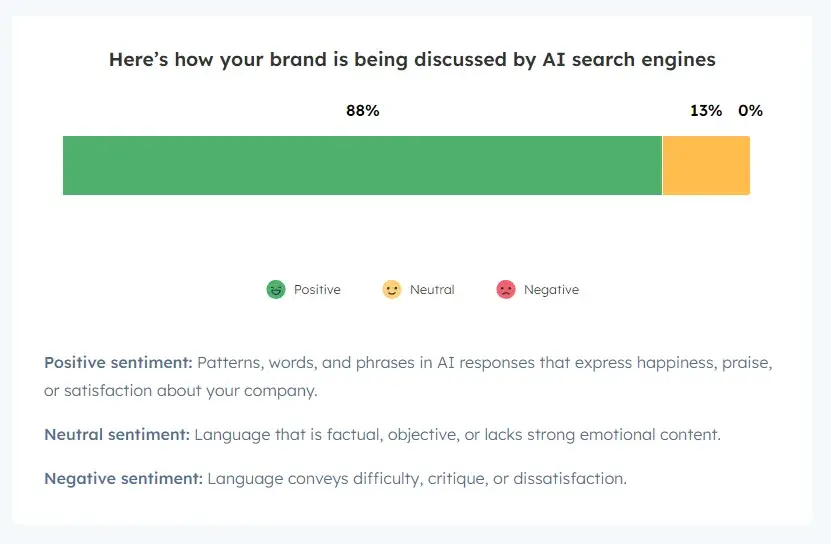
The tool gathers data, including perceived strengths and weaknesses. Consider using this data to inspire content that addresses weaknesses.
You already have the knowledge.
Although SEO can feel overwhelming with its 200 known ranking factors and algorithm updates, you already know much about what you need to share with your audience.
In one survey, 40% of entrepreneurs said they started their businesses because they were passionate about what they did. For many startups, entrepreneurs are solving problems they’ve encountered, so you know the audience’s pain points.
You can start writing helpful pages to solve the issues you once had, educate your audience, and lead them to your product or service.
I admit that it’s rarely enough to throw up content without being strategic, but knowledge and information are a huge part of SEO, and it’s the one area of the SEO process that startups can do exceptionally well in.
For larger businesses, connecting writers with subject matter experts can create a lot of friction. It’s time-consuming since everyone is busy, leaving well-intentioned writers to do their best to research complex topics.
But, if you’re the founder of a start-up, you likely are the expert. You can write content yourself or quickly connect with team members. Startups can be very agile.
How to Do SEO for Startups
Step 1: Set up Google Search Console.
Many of the startups I work with set up Google Analytics but are unaware of Google Search Console (GSC).
Google Search Console is my favorite SEO tool, and it’s completely free. Once established, it is the source of truth for your website and is better for keyword research than any paid tool. It tells you so much about your site.
I could write an entire article on the benefits of GSC, but I will focus on the major benefits for startups: when you start a new business, you don’t know what people are looking for to find your website.
Once your content is uploaded onto the site, it’ll start picking up visibility in Google and getting impressions and clicks. This data will be displayed in GSC.
Even if you’re not at the top of Google, you’ll still get information about what pages are ranking for. When you know what a page ranks for, you will know which keywords to optimize.
Here’s a screenshot from GSC. You can see the queries for which this site is ranking. The keyword “best touring bikes” has 442 clicks but 26,329 impressions. The page is in position four.
From this data, as long as the keyword is good for business, you want to optimize the page for it.
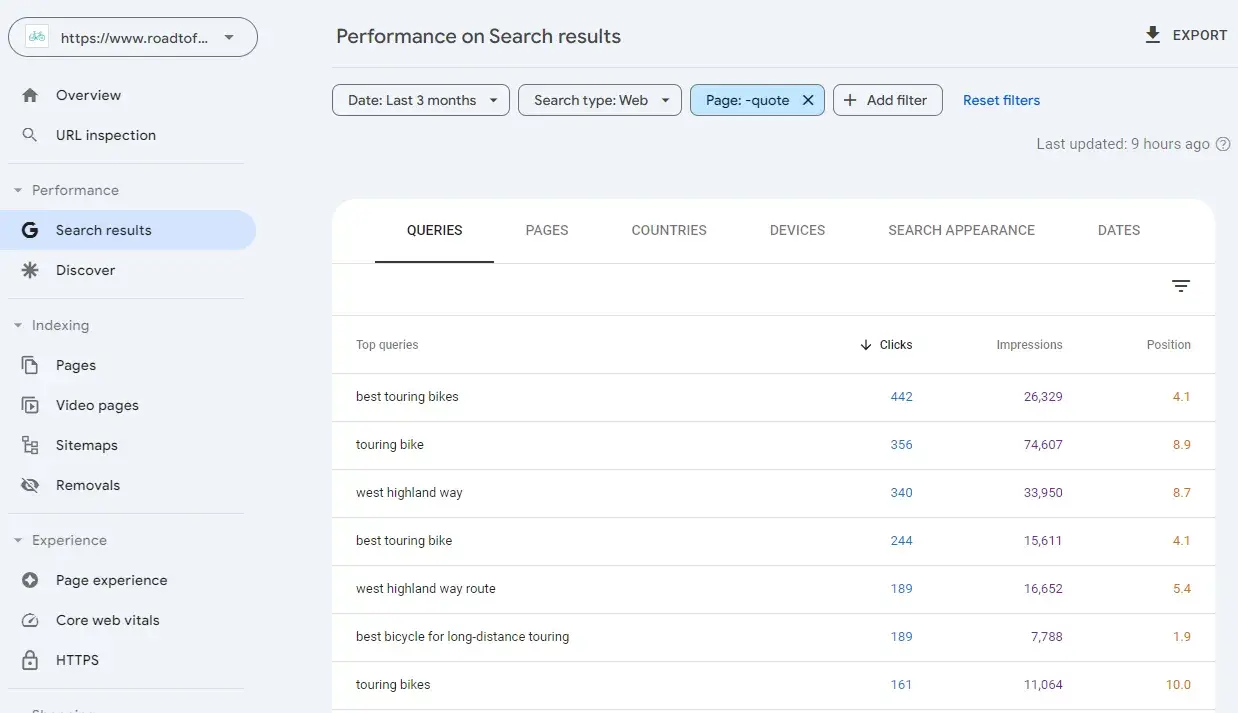
If you know your website isn’t ranking for anything yet, still set up GSC. For one, you want to gather the data as early as possible, and two, you can do so much more with this free tool, such as
Check inlinks
Monitor crawl errors
Submit sitemaps
Identify page experience and core web vitals
Request indexing for updated content
Monitor click-through rates (CTR)
And more.
Step 2: Do keyword research.
You know the drill: You type a burning question into Google and are met with hundreds of pages of search results.
But many of us never make it past that first page, making it essential for brands looking to reach new customers to get closer to the top of the SERP rankings.
The first step to ranking in Google is identifying relevant keywords and publishing content around them. Services like Ahrefs or Semrush can help you get started with identifying keywords related to your company’s niche.
I’ve used both of these tools and love them, but I admit, they are expensive. Their database of keywords is larger than cheaper alternatives, but if budgets are an issue, Keywords Everywhere is brilliant.
If you want free tools, Google Keyword Planner is great.
You need to sign up and create an ad, but you can leave it paused and still have access to the keyword planner. The screenshot below shows Google Keyword Planner and results for one keyword. I used “SEO for startups.”
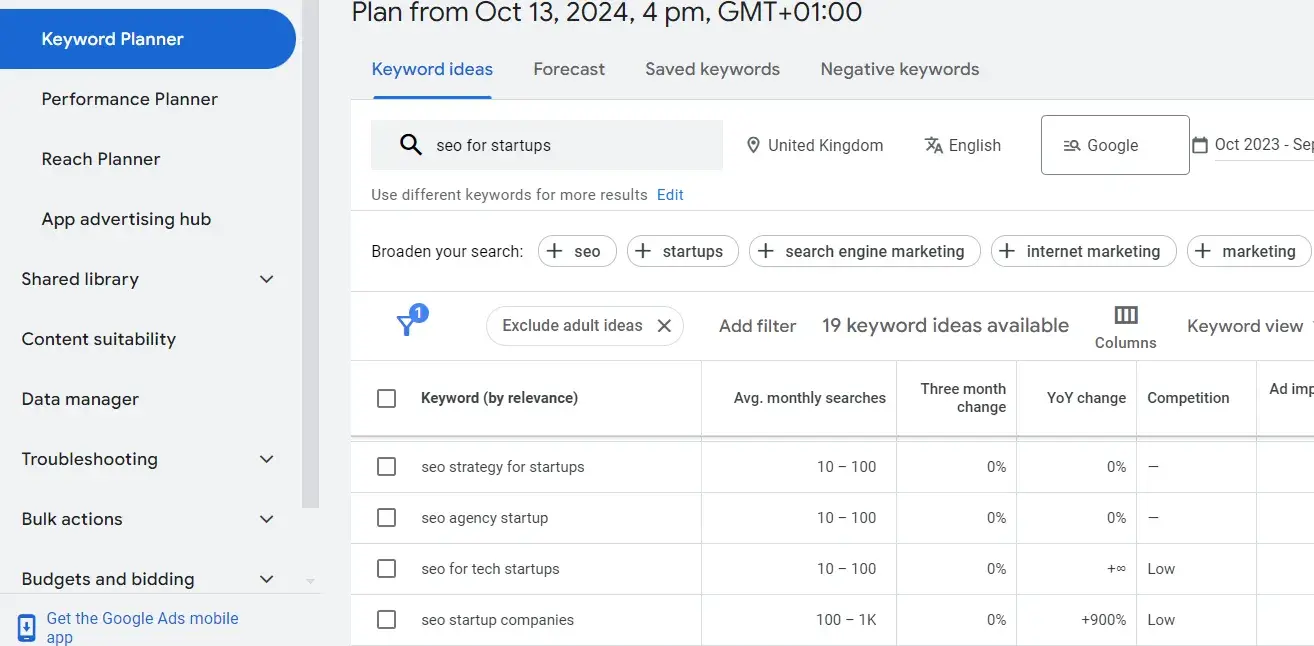
On keywords, Flavio Amiel, who runs the Audienz agency, says, “Aim for topical authority. This means covering the topics your potential customers are looking for, in-depth.”
Amiel says that once you’ve finished an SEO sprint for topical coverage, you can assess results and then cover an additional, new topic in a subsequent SEO campaign.
“And remember that positive results don’t always mean conversions. Amiel says they include everything from growth in support requests to customers clicking ‘add to cart’ or the business receiving press coverage.
“Once brands have identified the keywords that brought in good results, they can scale their SEO campaigns around those keywords with more streamlined processes and improved editorial style.
“A serious startup doesn’t want to dominate this or that keyword; they want to build a brand,” says Amiel.
Step 3: Keep an eye on competitors.
Tools like Semrush and Ahrefs, as mentioned above, can help you analyze competitor keywords and content. This can be a really useful tactic for startups, especially those with smaller budgets.
By looking at competitors, you can establish keywords they’ve tried and tested.
You can construct part of your strategy around:
Closing the gap.
Getting your website next to competitors in the SERPs.
Earning your fair share of clicks.
Competitors’ top-performing content can act as a source of inspiration for the content you create.
I urge everyone to be careful with this strategy: just because a competitor is doing it doesn’t mean you should. You need to consider your values, USPs, and audience.
Any piece of content that you publish on your website should feel totally authentic to your brand. Never do anything just because a competitor has done it.
If you catch yourself referring to content as “content” and “SEO content,” this might be an indicator that your content strategy isn’t quite right.
All content should be optimized, and all content should feel good enough to reach your audiences through other means (e.g., email or socials).
When you’ve completed your keyword research and competitor research, you should have a lot of keywords and content ideas that feel right for you. Next, you can optimize pages on your website to help you rank.
Step 4: Optimize your website structure.
Your website should have SEO-friendly URLs that are short and descriptive. Every page has one primary keyword. This primary keyword is generally the URL.
Website structure isn’t just about URLs; it’s more about how your website hierarchy works, the use of folders and subfolders, and how they are linked together.
Ahrefs has a great demonstration for an ecommerce website.
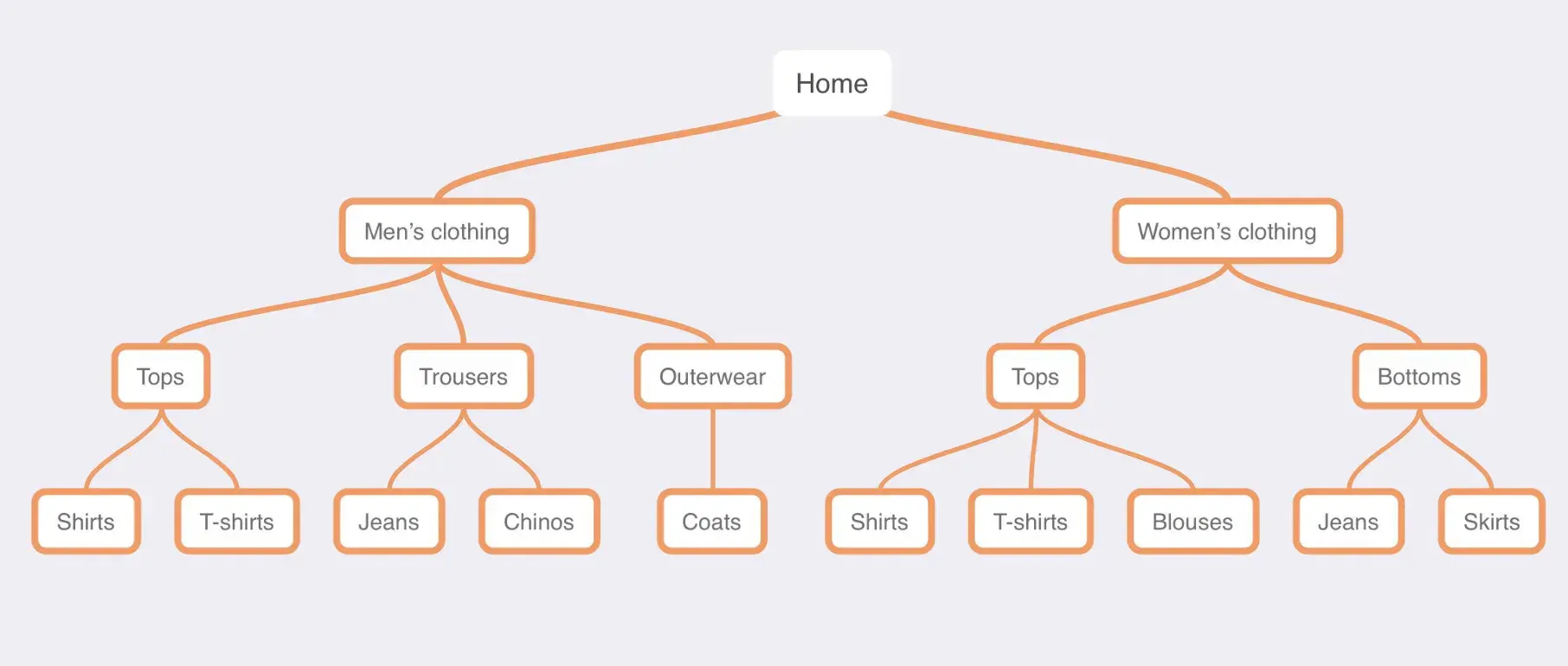
Your website hierarchy is key to navigation that is easy to follow for both users and search engine bots.

Your website structure should be optimized across your site, including your blog.

Although hierarchy is often a problem for startups, I do find the blog to be one of the most neglected areas. Treat your blog like the rest of your site, categorizing its contents in the same way you categorize your products and services.
Step 5: Implement on-page SEO.
Some guides will tell you to use keywords a certain number of times per article or word count, but that’s not how I do it. My best advice when it comes to on-page SEO is to:
Do your research on keywords, as mentioned above.
Use them strategically and based on search intent.
Create excellent content.
In my opinion, great content is the key ingredient for on-page SEO, but there are some rules that you can follow. For example, you’ll want to use your primary keyword in:
Title tags
URLs
Headers
Naturally throughout your article
Step 6: Create high-quality that matches search intent.
Above, I mentioned using keywords strategically and based on search intent. Later, there’s a tip and an example of how considering search intent changed everything for a startup.
Let me first define search intent. Search intent considers what users want when they type something into Google. If you understand the intent behind the search, you can best serve the searcher.
To discover the intent behind a keyword, I type it into Google and see what’s ranking. Google has a trove of data about your users, so whatever Google prioritizes in the results is likely what users want.
Here’s an example. Look at the screenshot below. I’ve provided the search results for the keyword “what is search intent.” This search returns informative blog articles. So, if I wanted to rank for that keyword, that’s what I’d create.
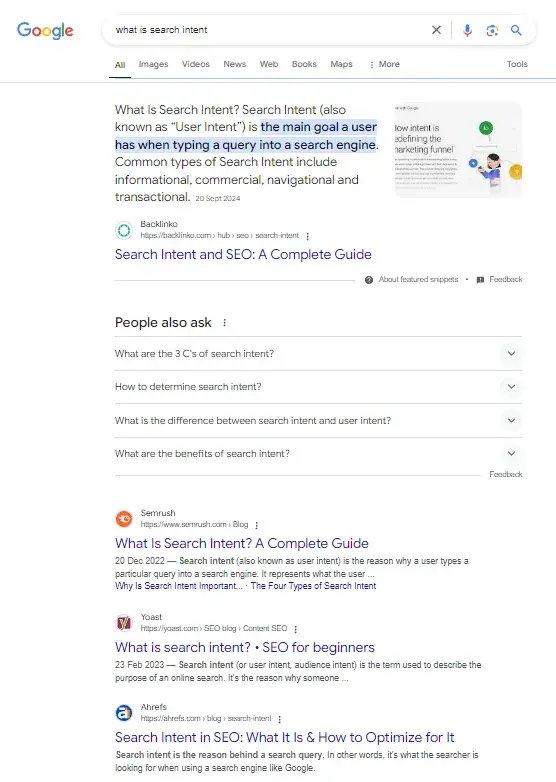
Now you know what search intent is, you want to write the highest quality content on Google. This will help you get a rank in those top spots.
You want to solve your reader’s problems, answer questions, and provide valuable insights or products and services just when your reader is looking for them.
If I found that videos were ranking well for a search like they do if you search “how to solve a Rubix cube” (see screenshot below), I’d be sure to make or embed a video to support my article.

Step 7: Utilize internal linking.
Internal linking is my favorite SEO tactic of them all. It’s easy, which means it’s also easy to make a mess of, but it is also incredibly powerful.
Internal linking is simply adding links between related pages within your website. Your main drivers should be A) navigation and B) helpfulness.
If you have a service page, for example, it would be helpful for that page to link to related case studies. This is helpful for your web users because they can see that you can do what you say you can, which might build trust and increase the chances of a conversion from that visitor.
When linking pages together, use descriptive anchor text naturally and where it makes sense. For example, instead of linking to an article with the text “read this,” it would be better to link using the article title or a keyword you want that page to rank for. The link must make sense within the context of the linking-from page.
Step 8: Build backlinks from reputable sites.
My rule on backlinks is that you don’t need to start until you’ve:
Optimized your website hierarchy.
Published a reasonable amount of pages (10 – 50, depending on the site).
Don’t try to cut corners and rush the backlinking process. It is one of the slowest SEO tactics you’ll start — a marathon, not a sprint.
Do everything free first:
Set up social media profiles and add your URL.
Put your site on relevant directories, as long as they’re relevant and genuinely useful for you to be listed.
Connect with journalists (there’s a tip and example of how this works later).
Create brilliant content that ranks on page one and earns links naturally.
Speak to your network and ask for links in return for content or expert insights.
Step 9: Continuously monitor and optimize SEO performance.
SEO is rarely a one-and-done marketing tactic. You must monitor and optimize SEO performance to gain insights into what you should do next.
This is where tools like Google Analytics and Google Search Console come in. You might also want to try other SEO tools.
Expert Startup SEO Tips
I wanted to provide the best possible SEO tips for startups, so I contacted my peers with direct experience. Below are some of my favorite tips from the experts working on startup websites daily.
I’ve provided my thoughts on each tip, too.
Tip 1: Consider search intent.
This tip came from Sonia Urquilla, an SEO consultant who works with coaches.
By considering search intent, Urquilla took an underperforming website to success with page one ranks, and her client’s site is also in AI overviews.
Here’s what Urquilla said: “My client, a career clarity coach, had been consistently posting weekly blogs, working with a copywriter, and even hired web designers to revamp her website and create new landing pages.
Despite all these efforts, she wasn’t seeing results — her organic traffic was at just five visitors per month, and her blogs weren’t ranking for her target keywords, getting zero organic traffic, and some were not even indexed.
Very early in our collaboration, I identified an opportunity to target relevant keywords specific to her audience’s needs and transformation.
Instead of focusing on broad, highly competitive terms like ‘career coach,’ we honed in on the transformation she provides: Career Clarity. We adjusted her keyword strategy to focus on terms like ‘career clarity coach’ and ‘career clarity.’
The results were incredible — she ranked on the first page within just four weeks.
This change brought in qualified organic traffic, leading to newsletter sign-ups, masterclass registrations, and consultation calls, all from people genuinely interested in her services.”
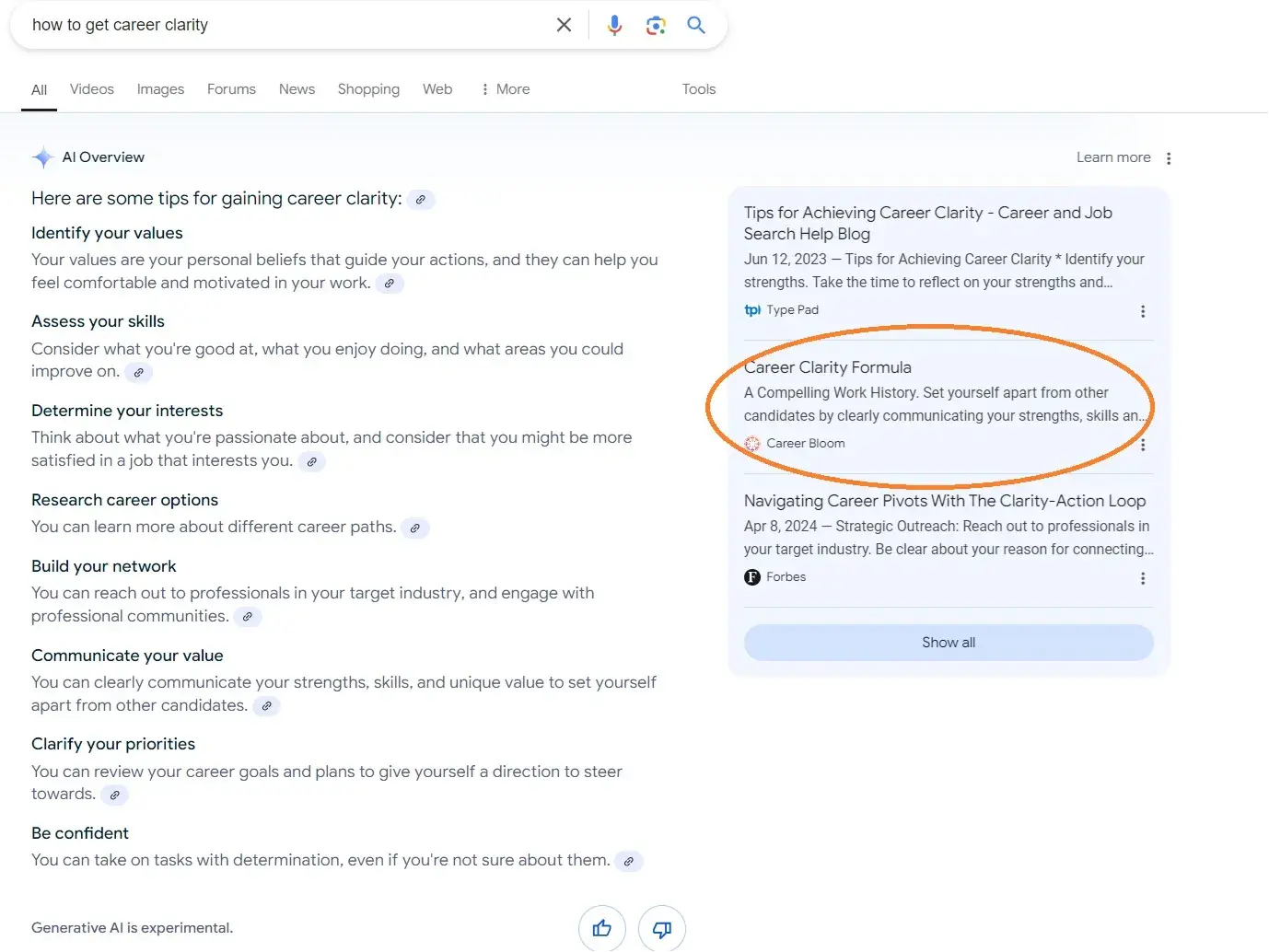
“For startups, focusing on relevant keywords can be a game-changer. It ensures that your content meets the needs and answers the questions of your dream clients,” Urquilla continues.
“I see a lot of startups and clients targeting trending but irrelevant keywords, resulting in unqualified traffic and low conversions. Avoiding this is essential.”
What I think about this: Search intent is incredibly important for SEO. As soon as I understood search intent, my SEO career improved significantly. I love a manual check of a user’s search intent.
Tip 2: Use landing pages to educate your audience.
Courtney Garner, Senior SEO Account Director at Refinery Group, made an excellent point about startups with new products.
She said, “Startups often need to gain brand recognition and introduce a new product to a market that may not know the product exists.”
I’ve experienced this while working with startups in my SEO career, so I loved what Garner had to say.
Garner continues, “I previously worked with a company that offers zero percent interest financing for car repairs. Most people are aware that car finance exists, but they don’t know that you can finance the repairs on a car, leading to very few searches for ‘car repair finance.’
In this case, our SEO strategy targeted used local landing pages optimized for searches about local car repairs, which meant that we introduced potential customers to this new solution at the precise moment they needed it most.
Simultaneously, we launched a PPC strategy to deliver ads directly to these users.
By combining these approaches, we successfully captured the attention of potential customers looking for what they needed but introducing them to a solution they didn’t previously know was possible.
The campaign drove a 654% increase in credit applications in the first 60 days in the first 60 days of the campaign.”
What I think about this: I love Garner’s approach here. When I worked with a startup with a new product, there were no searches for it because no one knew it existed. Knowing I couldn’t drive people to the product page with the product keyword, I worked on blogs and landing pages that were related to the product so we could educate the right audiences on this new solution.
Like Garner, I also worked with a paid ads specialist who could retarget audiences and help us get clicks while the SEO strategy started. With this approach, we saw a 366% increase in traffic, a 447% return on ad spend, and an 80% increase in revenue. This tip works!
Tip 3: Build trust.
At the heart of search is trust: for brands to be truly successful, they need to not only show up in search results but also provide accurate, helpful content that keeps readers and customers coming back time and again.
In HubSpot’s survey of web analytics pros, 39% said trustworthiness was the most important factor in ranking highly on SERPs.
Part of building credibility in SEO is building backlinks (when another website links to your content, citing you as an authority on the subject).
The more backlinks, the higher you rank, but securing backlinks is notoriously difficult since it often entails cold emails to other publications and a low success rate.
“Once you start heading into the more commercial, competitive topics, you have no chance of ranking without backlinks,” says Sam Oh, the VP of Marketing at Ahrefs. “Backlinks still matter, and they’ll still matter for the foreseeable future.”
“Backlinks come from thought leadership and thought leadership can be won by continually publishing high-quality, accurate content that serves your readers.
“Basic information has already been answered, so add more depth to whatever questions you want to answer,” says Amiel. “Create your own imagery. Build your own community. Build a personal relationship with your clients. Understand your customer’s pain points well.”
Some of his other tips: Be succinct, offer actionable solutions, stay on topic, and never break your reader’s trust.
What I like about this: The key word here is “trust,” and to build backlinks that build trust, you need to build the right links. Don’t focus on domain authority; focus on relevancy and quality.
HubSpot’s survey respondents (300+ web strategists and SEOs) voted domain authority as one of the least important metrics when considering website performance. Domain authority as a metric of website performance won only 10% of votes, along with bounce rate.
Tip 4: Check competitor backlink profiles.
Ben Goodey is an SEO for whom I have a lot of respect. He’s very active on LinkedIn and connects the wonderful SEO community with SEO experts through his podcast How the F*ck, where he interviews SEO pros and shares their incredible case studies.
Goodey is an SEO consultant, and almost all his clients are startups. Goodey’s top tip on SEO for startups is that startups shouldn’t neglect backlinking.
He says, “For six months this year, I worked with a startup in the HR tech space. I vastly underestimated the competitive headwinds we‘d face ranking content in this space — direct competitors had big brands, a five-plus-year head start, and budgets to pay the BEST writers and buy top-tier backlinks.
I’d estimate they easily had a budget of $60,000/month, whereas we had about $10,000 to spend on content, which is reasonable, but even then, this was a seriously difficult challenge.
We expanded the budget slightly and started building backlinks. Now, when new content was released, we would build several backlinks to the pages, and it’s no surprise that things started moving quickly. Traffic has been up 20% each month for the past six months following this strategy.
So, this is a lesson for everyone in ‘startup’ mode who thinks they can focus on quality content only: if your competitors are super strong, don’t forget to build backlink authority. You need it!”
What I think about this: For many sites, there comes a time when you need to build links. My advice is that you don’t buy a bunch of cheap and irrelevant backlinks. Relevancy is key. There are plenty of ways to build links cost-effectively.
You can start with your network and help them create content so they can credit you, ask your customers to credit you with their success if they write articles, etc.
You can also connect with journalists free of charge; this leads me nicely to the next tip for startup SEO.
Tip 5: Connect with journalists.
Sam Browne is the founder of HARO SEO, so he knows better than anyone the value of pitching to journalists.
For one client, PenFriend, Browne and his team used expert quotes from journalists to build 20 high-quality backlinks to their new website.
Browne says, “Building high-quality links is a challenge for any business, let alone a startup with a brand new website.
Journalists use sites like Connectively and Featured to source expert quotes for articles on some of the world’s most respected publications. Our team responds with expert quotes tailored to meet the journalist’s requirements.”
For PenFriend, the HARO SEO team secured links in major publications like Tech Bullion.
What I think about this: I am a huge fan of this kind of backlinking. The best part is that it is completely free. All you need to do is sign up for a platform. I love Featured, but as Browne said, there’s also Connectively.
Other platforms include Help a B2B Writer and Qwoted. You can also use the hashtag #journorequest on X to find journalists seeking specific insights.
Startup founders or entrepreneurs are among the most passionate people I’ve met. Entrepreneurs can easily give journalists incredible value. I recommend that all my clients, especially those with smaller budgets, sign up.
The screenshot below shows my Featured profile with some of the backlinks I’ve earned to improve my startup’s SEO.
I’ve had a 57% success rate on Featured, so 57% of my pitches are successful and result in a backlink, a good return for my efforts.
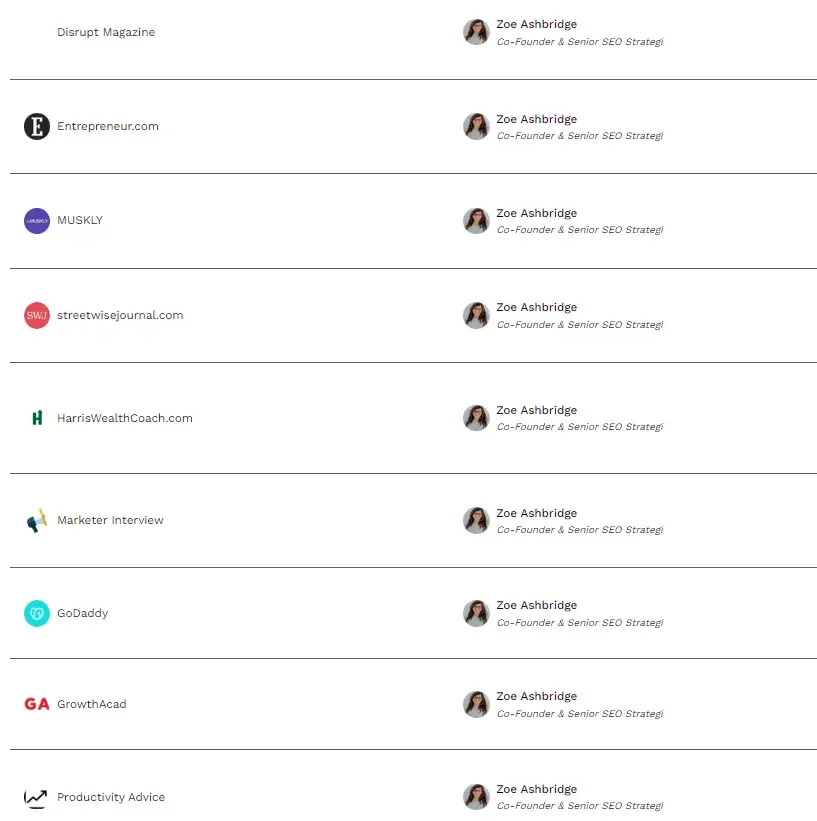
Tip 6: Meet your audience where they are.
When creating content, it’s important to prioritize not only what your customers want but also where they want to find it.
A HubSpot survey of more than 600 adults found that 31% of consumers use social media when searching for answers to questions online — and one in four ages 18-54 prefer social to search engines.
Among social media users, 57% use the search function on social apps (79% for Gen Z and millennials).
People are also increasingly searching for content from their phones, with 57% of consumers reporting using their phones over any other device when looking up a question on a search engine (a number that rose to 80% for Gen Z).
These figures should be top of mind for startups looking to grow their business through content. Having an active social media presence and a user-friendly mobile experience will be important for brand recognition and SEO and building credibility as a thought leader in the eyes of younger generations.
Tip 7: Utilize AI tools.
AI has changed content for many brands, including startups. Of 400 web analysts surveyed, more than half said their blogs incorporate AI tools into their workflow.
Brands that want to position their content for success in the coming year should get started now with understanding how AI tools and search could help their growth.
Artificial intelligence for SEO can help with all stages of content creation, from coming up with article ideas based on your research-backed keywords to drafting the articles, writing headlines, and coming up with social media captions.
How artificial intelligence will impact search remains to be seen, but 75% of web analysts believe AI search integration would have a positive impact on their blog.
Some AI use cases Amiel suggests to startups:
Use generative AI tools such as ChatGPT to brainstorm blog topic ideas.
Use tools like Swiftbrief to write first drafts of SEO content briefs before passing to a writer.
Generate meta titles and meta descriptions.
“Most AI tools are not mature enough to fully trust them to write content,” says Amiel. “You can experiment with different approaches to make some of your work easier, more efficient, and/or more creative.”
Whether generative AI or a journalist is cranking out your blog posts, one thing is clear: Content is an important aspect of growing a business.
If you can meet your audience where they are while delivering relevant, trustworthy content, that’s a recipe for success.
What I think about this: I really like AI as a tool, and HubSpot has some fantastic AI and SEO tools to support startups.
I agree entirely with Amiel, though. While AI is great, I agree that most tools are not good enough to write content fully. It can, however, be used to speed up the process; be sure to review and edit every word.
Start Up Your SEO Strategy
If ranking on Google feels right for you, I advise starting SEO as soon as possible.
There’s no hiding from it: SEO takes time, so the sooner you start, the sooner you can reap the benefits.
Remember, when you start an SEO strategy, you’ll do much more than just do SEO. You’ll learn more about your audience, share insights with other areas of marketing and sales. Even better, your hard work compounds.
Future you will be happy that you got started today.
Editor’s note: This post was originally published in August 2023 and has been updated for comprehensiveness.
![→ Download Now: SEO Starter Pack [Free Kit]](/wp-content/uploads/SEO-Step-by-Step-Tutorial-3-Essentials-for-Beginners-Next-Steps.png)



